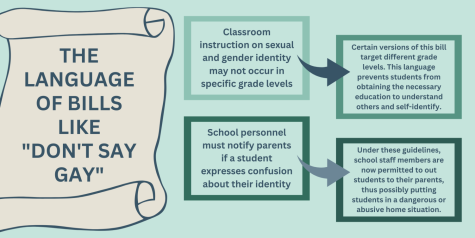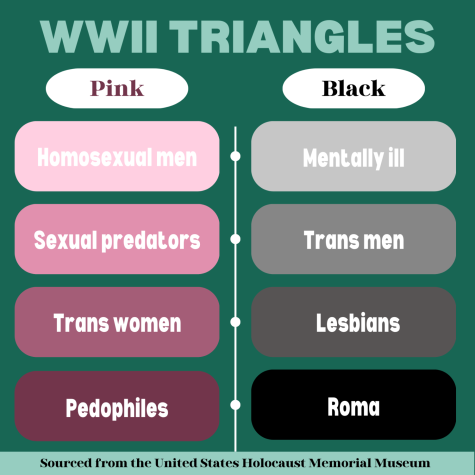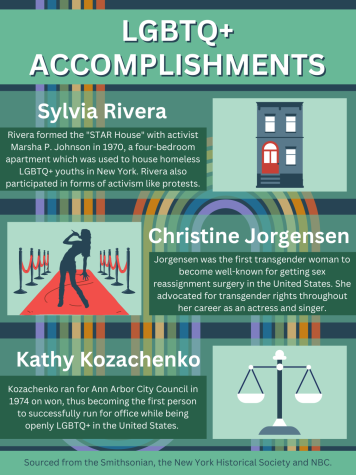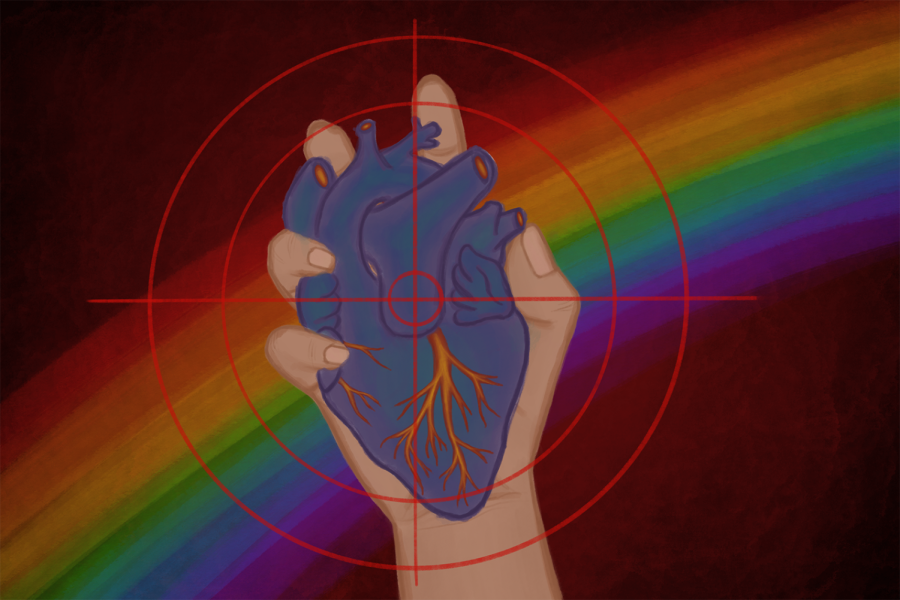Your donation will support the student journalists of Parkway West High School. Your contribution will allow us to purchase equipment and cover our annual website hosting costs.
Countless anti-LGBTQ+ attacks occur worldwide each year. Whether it’s a deadly shooting or hateful comments in the classroom, discrimination against LGBTQ+ people persists despite strong advocacy for LGBTQ+ rights.
Targeted for existing
How attacks against the LGBTQ+ community cause widespread trauma, fear and feelings of exclusion
April 24, 2023
Slurs and hateful words are spray-painted across colorful pride murals. Articles flood news sites as another LGBTQ+ club shooting is announced. Books are pulled off of shelves, and inclusive movies cause outrage in online communities.
Time and time again, LGBTQ+ safe spaces are violated. The busy, happy places of free expression that resulted from increased LGBTQ+ rights have now become memorial sites of violent hate crimes and lives lost too soon. Educational spaces are censored and forced to lock away everything that does not fall under heteronormative ideals, no longer allowed to share vital information about a vibrant world of diversity. Parents choose to send kids to conversion therapy to “fix” them, forcing children away rather than uplifting them.
This discrimination and harassment stem from seemingly very little reason, with LGBTQ+ people becoming the scapegoat for those with misguided anger and hate. Rather than assessing the true value of human life, many choose to perpetuate discriminatory stereotypes and enable the deaths and banishment of LGBTQ+ individuals.
The outcasting of LGBTQ+ people has devastating effects. Through forming laws that remove a vital part of a person’s being, governments across the globe set citizens up to live unfulfilling, unhappy lives. According to Maslow’s Hierarchy of Needs — a pyramid of levels that determine the stages that must be achieved to live a fully satisfactory life — love and belonging are the third-most important step in lifelong success, following physiological needs and safety needs. When a person cannot acquire these needs, they will be unable to reach the higher levels of the pyramid: esteem and self-actualization.
Maslow’s theory outlines the steps needed to find happiness in life, yet we are actively taking away vital basic rights for LGBTQ+ people, continuing to progress in the wrong direction. Almost 8% — 20 million — of the United States adult population is LGBTQ+, yet same-sex marriage was only just federally legalized in 2015 — with many still fighting against it today. We live in a society where countless people are more willing to prioritize their out-dated and harmful opinions rather than allow everyone to thrive as a productive member of society. These actions are deadly, allowing human beings to be targeted for existing.
Censored for existing
The suppression of LGBTQ+ discussions in educational spaces became officially legal with Florida’s “Parental Rights in Education” — otherwise known as the “Don’t Say Gay” — bill, and now we’re seeing it happen again in Missouri’s “Vulnerable Child Compassion and Protection Act” (SB 134). This new bill targets LGBTQ+ discussions even further, aiming to ban all discussions of LGBTQ+ subjects from kindergarten to high school, as opposed to the “Don’t Say Gay” bill, which originally only targeted kindergarten through third grade up until a recent change targeting all grades. These bills do not truly aim to “protect” children from exposure to inappropriate subjects at a young age; they aim to eradicate all discussions of LGBTQ+ topics from the classroom, further censoring an already marginalized group. LGBTQ+ discrimination is quickly spreading into educational spaces that should be open to learning about acceptance and kindness.
“There were some people saying [the bill] was to protect kids from sexualization, or that kids don’t know who they are because they’re just kids, but when I was a kid, I knew exactly who I was; I just didn’t know the terms for it. If I did know what gay meant or what trans was, I would have very easily been able to say who I was because that never changed. I just learned new terminology,” sophomore Ash Herring said.
However, the implications of SB 134 have much more dire effects than just a lack of education. Current drafts, such as Missouri’s Senate Committee Substitute for Senate Bill No. 134, assert that any educational personnel who have received information of a student’s change in sexual or gender identity must notify the student’s parents within 24 hours. The parents must also be notified when a student requests to use a name or pronouns that are not officially associated with the student’s assigned gender at birth, and teachers may not encourage or introduce students to gender reassignment therapy or surgery. In other words, SB 134 requires all teachers to out students who share this confidential information with them in the same way a teacher is required to report mentions of self-harm or suicidal ideation, further insinuating that these lawmakers correlate the “dangers” of being non-heterosexual to harming oneself. Teachers who do not comply would be at risk of losing their teaching licenses. Currently, Parkway requires that teachers report many things, including but not limited to possible abuse, sexual harassment, self-harm, safety concerns and drug use.
The ramifications of this bill transcend the individual, the classroom and the education system itself. When a minor is outed to their parents, they are at a much higher risk of being disowned, and as disownment rates increase, so does homelessness. In fact, The Trevor Project found that 28% of LGBTQ+ youth reported experiencing homelessness or housing insecurity, and 14% of LGBTQ+ youth reported being abandoned or kicked out by caregivers.
Overall, as a society, we generally agree that homelessness is not a fair living condition for any human being, regardless of how they ended up in the situation. However, this bill is fighting for the exact opposite: being outed directly correlates to an increased risk of homelessness, and for what, simply existing? If anything, it’s odd that fully grown adults are obsessing over minors’ sexualities and gender identities, identities that present no danger or risk to other students. Just as a cishet student can exist without being questioned and censored, an LGBTQ+ student deserves the same rights.
This is especially essential due to a lack of basis for censorship. In many schools, health classes contain units on the human body and heterosexual relationships, and in almost every classroom, heterosexual relationships are casually mentioned daily, such as teachers mentioning spouses or students mentioning partners. There is no reason to exclude LGBTQ+ people from the same privilege. Bills like SB 134 and “Don’t Say Gay” limit learning spaces by imposing religious values onto students who may not be a part of those or any religions. Many of these people preach to “love thy neighbor” — unless, of course, “thy neighbor” is gay.

“A lot of the time, people use religion to defend intolerance. There’s nothing wrong with not knowing or not understanding, but there is something wrong with not accepting,” Herring said. “I’m not a Christian, personally. My family is mostly Christian; they are very accepting of other people and other religions. Unfortunately, sometimes very religious households can be very unaccepting towards people in the queer community.”
Some of the most commonly known religions in opposition to LGBTQ+ individuals include Jehovah’s Witnesses and evangelicalism, whereas religions like Unitarian Universalism are almost fully accepting. This begs the question, why do one religion’s values precede another? The truth is, they shouldn’t — especially when those values create a gateway to increased youth homelessness rates and escalated mental illnesses.
While mass shootings, new laws and hate crimes are much more frequently covered in the media, there are still smaller, unnoticeable forms of discrimination occurring daily that are just as deadly. These occur in the forms of biased remarks, cyberbullying, exclusion and harassment. The GLSEN 2021 National School Climate Survey showed just how common these anti-LGBTQ+ incidents are and in turn, how commonly they get dismissed by staff and administration.
Though a small comment in passing may seem insignificant, the overwhelming amount of these comments and perceived “small” actions add up to a much larger monster. In the climate survey, over 30% of LGBTQ+ students reported being physically harassed in 2021, and over 10% reported being physically assaulted, all based on identity. Additionally, over 60% of LGBTQ+ students have never reported instances of victimization to school staff. Out of the reported occurrences, over 60% of the time, staff and administrators took no action. This is the issue: LGBTQ+ discrimination has been so deeply ingrained into society that students are learning to stay silent instead of reporting since reported instances often go ignored or brushed aside. It is imperative that these issues are addressed in classrooms so that we may begin to form an understanding society and an accepting learning space.
What may seem to be a simple form of censorship to lawmakers — who have little else to do than force LGBTQ+ minors into potentially dangerous living situations — is a threatening omen of the future: LGBTQ+ censorship is becoming increasingly prominent once again and for nothing more than pure existence.
Banished for existing
The widespread anti-gay mindset is not new, having impacted LGBTQ+ people in America in the 60s and 70s and shutting down designated gay bars that served as safe spaces for many community members. However, the LGBTQ+ community eventually sought to end this discrimination.
Though various riots occurred years before, the historic 1969 Stonewall Riots in Greenwich Village, N.Y. are widely regarded as the “spark” of the LGBTQ+ rights movement. But this spark did not happen overnight. The need to create change resulted from years of hate crimes and discriminatory laws. At the time, bars were prohibited from selling alcohol to LGBTQ+ people, and LGBTQ+ people were not allowed to dance together in public. Furthermore, the New York gay bar scene was widely run by the Mafia, who bribed the police to only raid the bars at “convenient” — less busy — times and made large profits off of LGBTQ+ people looking for a safe space to be themselves. In Stonewall’s case, the Genovese crime family purchased the establishment to convert it into a gay bar. While the Mafia made it possible for gay bars to exist with less interruption, their intentions were not to help the LGBTQ+ community; rather, they were exploiting a vulnerable group for some extra cash, hence why all of these circumstances combined finally ignited the spark of the revolution.
On the night the Stonewall Inn was raided, patrons who had been kicked out decided to gather outside the establishment instead of leaving. Eventually, members of the police barricaded themselves inside the bar. At the same time, the patrons outside began throwing bottles, coins, rocks and other objects at the door barricade and the police outside. The group steadily grew as news spread throughout the village, leading to a protest over five days as various groups came and left. Historically, this was the first major and well-recognized riot against police officers for LGBTQ+ rights.
Protests like these paved the way for discriminatory law removal and increased protections for the LGBTQ+ community. As with these anti-LGBTQ+ laws from the 1900s, many lawmakers and lobbyists now still view their homophobic actions as helping “misguided souls” rather than doing genuine harm to individuals. Sophomore Mya Jenkins is bisexual and has seen the effects of this viewpoint.
“My personality has changed; I have an on-and-off button of who I am versus who I am at home,” Jenkins said. “There’s already stereotypes about Black people. Being a part of the LGBTQ+ community makes [those stereotypes] worse, and it makes my anxiety start kicking in. Especially in Black family households, parents automatically assume that gay is wrong, so when your parents don’t accept you for who you are, it’s obviously going to take a toll on your mental health and who you are as a person.”
In fact, some may think they are serving their communities by eradicating the presence of LGBTQ+ people. This attitude is further seen in those who condone conversion therapy.
Conversion therapy is a procedure in which a religious official or “psychologist” attempts to alter an individual’s sexuality or gender identity in hopes of upholding an entirely cishet society. This practice partly stemmed from the American Psychological Association’s (APA) original classification of homosexuality as a mental illness. In doing so, the APA encouraged and endorsed using these “therapy techniques.” This created the long-held opinion that being LGBTQ+ was not normal and something that needed to be “fixed.” However, in 1973, the APA officially declared that homosexuality was not a mental illness and therefore supported laws allowing gay individuals the same rights as any other citizen.
Despite this alteration, the damage had been done. Today, conversion therapy is still practiced in some areas of the U.S. In fact, a 2019 study by the Williams Institute found that over 600,000 LGBTQ+ adults have reported receiving conversion therapy at some point. The same institute found that LGB individuals who have experienced conversion therapy are 92% more likely to have lifetime suicidal ideation than those who have not experienced conversion therapy. Rather than celebrating identity, teens are sent away to churches, camps or even wilderness therapy — a practice in which “troubled teens” are forced to spend months doing physically grueling activities in the wilderness, often led by adults who are verbally and physically abusive.
So while this practice is called “therapy,” it is anything but — conversion therapy uses tactics to misrepresent the root of LGBTQ+ identity. In these sessions, “therapists” typically identify childhood factors such as parental divorce, unemployment or the breaking of gender roles as reasons for “becoming” LGBTQ+. These “causes” fail to recognize that being LGBTQ+ is not a choice, nor is it something that needs to be changed.
The 2020 Trevor Project National Survey on LGBTQ Youth Mental Health found that 10% of LGBTQ+ youth reported experiencing conversion therapy at some point. Considering the dangers of conversion therapy, this percentage should be zero. Many conversion therapies can include practices such as sexual and verbal abuse, isolation, exorcisms, food deprivation, electrocution and forced medication.
LGBTQ+ teens subjected to these practices are at higher risk for developing mental illness, even leading to suicide in some cases, as was with 17-year-old Leelah Alcorn in 2014. After being ridiculed by her parents for coming out as a transgender woman and sent to Christian therapists, Alcorn decided she would rather take her own life than continue living in an unaccepting world. With this action, Alcorn wished to bring awareness to the struggles that LGBTQ+ teens face in unaccepting societies, being treated inhumanely and ridiculed for expressing their identity.
We have failed to protect our youth from assault and abuse. The subsequent effects are detrimental — teens learn to become ashamed of their identity, to hide away and live an untrue, unfulfilling life. When we could be celebrating the diversity of human identity, we are now instead mourning the loss of those who were silenced by hate.
Murdered for existing
The issues do not just end at censorship and banishment — in fact, this is just the tip of a much larger iceberg. During World War II, citizens suspected of being LGBTQ+ were forced into concentration camps.
Though homophobia and transphobia existed far before World War II, discrimination became especially prominent — specifically in Germany — as the war grew. Along with Jewish people, political prisoners and those considered “asocial,” LGBTQ+ people were involuntarily removed from their homes and relocated to deadly concentration camps, though they were not specifically targeted for murder in the same way that Jewish people and Jehovah’s Witnesses were.

To distinguish each group from one another, prisoners would wear triangles on their clothes. The pink triangle, recently reclaimed as a symbol of LGBTQ+ pride, was worn by homosexual men, rapists and pedophiles. The black triangle was worn by those deemed “asocial” — those who did not conform to social norms — including Roma, those with mental illnesses or disabilities, drug addicts, beggars, prostitutes and lesbian women. By making these distinguishments, the triangle categories insinuated that gay men fell under the “sexual predator” umbrella and lesbian women were “asocial.” These harmful categorizations continued to enable long-held societal ideas that members of the LGBTQ+ community were strange, predatory or mentally ill.
In upholding the stereotypes surrounding LGBTQ+ people and sending them away to concentration camps, Nazi actions contributed to future discrimination against LGBTQ+ people, furthering the idea that people who “don’t fit the norm” should be sent away altogether.
However, homophobia is not solely an issue of the past. While there may not currently be issues such as mass relocations of LGBTQ+ people during wars, the LGBTQ+ community is still targeted by those with malicious intent. More recently, this is seen frequently in mass shootings and other hate crimes across the globe.
On Nov. 19, a shooter opened fire on Club Q, an LGBTQ+ club in Colorado. Five people died and many more were injured. The five victims included bartenders 28-year-old Daniel Davis Aston and 38-year-old Derrick Rump, 40-year-old transgender woman Kelly Loving, 35-year-old Ashley Paugh and 22-year-old Raymond Green Vance. Pulse nightclub, an LGBTQ+ nightclub in Orlando, was also targeted in 2016, leaving 49 dead and 53 injured. The community recognized the victims through a memorial and museum, though the mourning of those whose lives were lost never truly ends. These hate crimes murdered LGBTQ+ community members, people who were simply trying to exist in a space that they were told was safe. Nobody goes to a club expecting to be killed just for trying to exist; sadly, this was the case for over 50 people who attended Club Q and Pulse nightclubs on those days.
These shootings are just two instances out of over 10,000 hate crimes committed based on sexual orientation in the past 10 years; hate crimes against a community based around love and identity. Instances like these make us wonder, “Could I be next?” Not only do these hate crimes take away loving LGBTQ+ family members and friends, but they create a long-lasting sense of paranoia and fear, leading LGBTQ+ individuals to participate in a more cautious lifestyle than that of their peers.
Nobody should be subjected to the unnecessary mental strain of paranoia and grief, regardless of whether others agree with their identity, and nobody should be targeted because of their identity. Hate crimes take an incredible toll on LGBTQ+ individuals, and it is essential that we work to prevent these from happening through education and stricter anti-discrimination policies.
Educating about being targeted for existing
While certainly vast in range, these examples of discrimination are nothing but a small look into the daily struggles LGBTQ+ people face. Discrimination, harassment and hate crimes all affect higher mental illness rates among LGBTQ+ teens. However, these truths should not just be silently accepted. To allow every person to reach their full potential, regardless of gender or sexuality, we must work toward cultivating an inclusive environment.
“I honestly think that [anti-LGBTQ+ people] are closed-minded. Everybody was born to live their own life, and their sexual preference shouldn’t matter because it’s not [those people’s] lives,” Jenkins said.

School curricula should accurately reflect the struggles that LGBTQ+ people have overcome and are currently facing. LGBTQ+ people play a large role in history worldwide, whether it be famous historical figures who happened to be LGBTQ+ or LGBTQ+ activists who fought for change. Even just acknowledging the work LGBTQ+ people have done contributes widely to feelings of belonging among LGBTQ+ students, who may have never seen themselves represented in history otherwise.
Educational settings such as health classes must also make a strong effort to provide education applicable to everyone, not just cisgender or heterosexual students. This education would most importantly include information about all sexualities and gender identities as well as available resources for those who are questioning or experiencing mental health issues in relation to identity. With mental illness being much higher among LGBTQ+ teens, it is imperative that we provide students with the proper resources to access help and information.
“It would be amazing if we talk more about the history of queer individuals. Trans people, gay people, queer people; it’s not new. It hasn’t been new. It’s been around for years. The newer thing is being against queer people,” Herring said. “Be nice to queer people. They’re people like us. We’re all humans; no matter who we love or how we identify, we’re just people trying to figure out our lives.”
Additionally, we must educate ourselves about LGBTQ+ history and work to undo our preconceived notions about the LGBTQ+ community, which have been born from existing in a heteronormative society. For far too long, these biases and subsequent hateful actions have been brushed under the rug, ignored by those who have little care for the LGBTQ+ community.
“As far as school, I have faced discrimination. I’ve had people call me different slurs or different names. I’ve had people try to out me. I’ve never been secretive about my identity; if someone knows I’m trans, that’s fine. But I don’t like when people try to out me because it makes it seem like I’m ashamed of who I am when really I love who I am. I love being a trans woman,” Herring said.
Viewing LGBTQ+ people in a hateful manner continues ostracization that has gone on for far too long. If we as a society want to truly reach a stage in which every person is accepted and holds a sense of belonging, we must actively work to create change within both our communities and our minds — we have to stop targeting people for existing. It is not wrong or “sinful” to be LGBTQ+; it’s human.



Will Gonsior • Apr 24, 2023 at 8:27 pm
Thanks for another thorough and altogether necessary article, Addie! I can tell this one meant a lot to you.
If you don’t mind, I have a couple of minor nits to pick. (I get it, I can be a snob sometimes.) First, I don’t think your question of why some religious beliefs are prioritized over others was well thought out. Everyone has a worldview, and no person’s worldviews should be treated by the state as more or less valuable. The way that people’s worldviews become legislatively impactful is through elections of leaders, who then (hopefully) use their own views of what is right and wrong, which the public (hopefully) were informed of when these public servants were elected, to govern. It’s not perfect by any means, but democracy has proven to be the most effective system of governance; whether the prioritization of some religious beliefs over others is a “feature” or a “bug” is up to you but it most definitely is ingrained into how the system works.
Second, there is nothing wrong with not accepting. Sure, the sentence seems innocuous in this context where it improves people’s mental health, but acceptance is not something that people should be negatively pressured into. (I don’t mind some positive pressure on state-recommended worldviews, which is otherwise known as education and is not only a convenience but a right.) We should all be loving to our neighbors (no harm in pressuring people into that), but the idea of forcing acceptance of ideas on people in general is not really humane, and it’s not good for traditionally marginalized populations like the LGBTQ+ community either — it’s that kind of thinking that motivates the rougher types of conversion therapy.